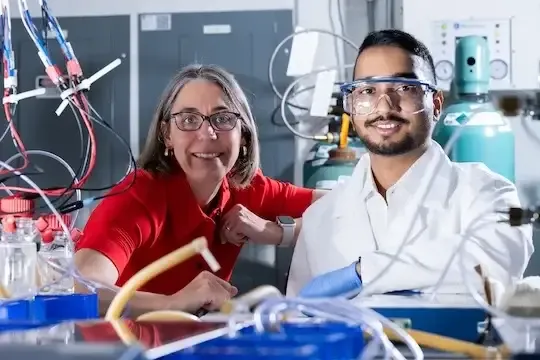new findings
Houston researchers make breakthrough on electricity-generating bacteria

A team of Rice researchers, including Caroline Ajo-Franklin and Biki Bapi Kundu, has uncovered how certain bacteria breathe by generating electricity. Photo by Jeff Fitlow/Rice University.
New research from Rice University that merges biology with electrochemistry has uncovered new findings on how some bacteria generate electricity.
Led by Caroline Ajo-Franklin, a Rice professor of biosciences and the director of the Rice Synthetic Biology Institute, the team published its findings in the journal Cell in April. The report showed how some bacteria use compounds called naphthoquinones, rather than oxygen, to transfer electrons to external surfaces in a process known as extracellular respiration. In other words, the bacteria are exhale electricity as they breathe.
This process has been observed by scientists for years, but the Rice team's deeper understanding of its mechanism is a major breakthrough, with implications for the clean energy and industrial biotechnology sectors, according to the university.
“Our research not only solves a long-standing scientific mystery, but it also points to a new and potentially widespread survival strategy in nature,” Ajo-Franklin, said in a news release.
The Rice team worked with the University of California, San Diego's Palsson lab to simulate bacterial growth using advanced computer modeling. The simulations modeled oxygen-deprived environments that were rich in conductive surfaces, and found that bacteria could sustain themselves without oxygen. Next, they confirmed that the bacteria continued to grow and generate electricity when placed on conductive materials.
The team reports that the findings "lay the groundwork for future technologies that harness the unique capabilities" of these bacteria with "far-reaching practical implications." The team says the findings could lead to significant improvements in wastewater treatment and biomanufacturing. They could also allow for better bioelectronic sensors in oxygen-deprived environments, including deep-sea vents, the human gut and in deep space.
“Our work lays the foundation for harnessing carbon dioxide through renewable electricity, where bacteria function similarly to plants with sunlight in photosynthesis,” Ajo-Franklin added in the release. “It opens the door to building smarter, more sustainable technologies with biology at the core.”